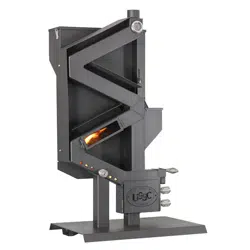Loading ...
Loading ...
Loading ...

© 2021 United States Stove Company
9
Install option one: When 8ft to 15ft length of venting is
used, utilize 3” diameter listed L vent pellet pipe. When
having to use more than 15ft of venting, then utilize a 4”
diameter listed L vent pellet pipe. In some installations
and because of outside environmental conditions, a
barometric damper may need to be installed immediately
o the top of the stove. This barometric damper will
prevent excessive draft which causes your stove to burn
hotter than normal and burn excessive fuel. You can also
adjust the bars closer together on the burn basket to
lower the temperature if it starts running too hot. See the
“Tuning Your Stove” section of this manual.
A 4” diameter listed L vent pellet pipe is recommended
if you decide to go through the wall, and you need to
terminate above the roof at least 24” using pellet vent.
When installing into an existing chimney, then you must
run 4” vent all the way up any existing chimney and
terminating at the top.
Install option two: Use minimum 24 gauge single wall
pipe in 4”, 5” or 6” diameter when connecting to listed
factory built chimney. Use a 3”-4”, 3”-5” or 3”-6” increaser
directly o the stove then connect to the required length
of pipe to reach the factory built chimney. A slip joint can
be used to allow connection to the factory built chimney
or a plug can be inserted at the entry point of the factory
built chimney. The connector pipe shall pass through
the plug a minimum of 4” or can pass through the entire
length of the chimney. When using this method install
another properly sized plug at the top of the chimney and
continue connector pipe out and above the plug at least
2”. Install proper sized cap or in the event factory built
cap is already in place with spark arrester, the connector
pipe can be terminated under the existing factory built
cap. When installing your stove, an all vertical stove pipe,
straight up and through the roof is best. This will ensure
a good upward draft that all stoves need to operate. The
more twists and turns you have in stove piping the more
it will restrict the draft. This is true for all stoves.
Extended Roof
Support Bracket
(Conduit not included)
Chimney Cap
Storm Collar
Adjustable Roof
Flashing
Firestop
Radiation
Sheild
Firesafe
Enclosure
Support Box
and Trim Collar
with built-in
Starter section
Stovepipe
TO STOVE
Twist-Lock
Chimney Sections
Attic Insulation Shield
IMPORTANT:
IT IS IMPORTANT FOR THE STOVE PIPE TO EXTEND
TO AT LEAST AS HIGH AS THE HIGHEST POINT OF
YOUR ROOF.
Any reduction in clearance to combustibles may only be
done by means approved by a regulatory authority. Install
vent at clearances specified by the vent manufacturer.
COMBUSTIBLE WALL CHIMNEY
CONNECTOR PASSTHROUGHS
Method A. 12” (305 mm) Clearance to Combustible
Wall Member: Using a minimum thickness 3.5” (89 mm)
brick and a 5/8” (16 mm) minimum wall thickness clay
liner, construct a wall pass-through. The clay liner must
conform to ASTM C315 (Standard Specification for
Clay Fire Linings) or its equivalent. Keep a minimum of
12” (305 mm) of brick masonry between the clay liner
and wall combustibles. The clay liner shall run from the
brick masonry outer surface to the inner surface of the
chimney flue liner but not past the inner surface. Firmly
grout or cement the clay liner in place to the chimney flue
liner.
INSTALLATION
Loading ...
Loading ...
Loading ...
